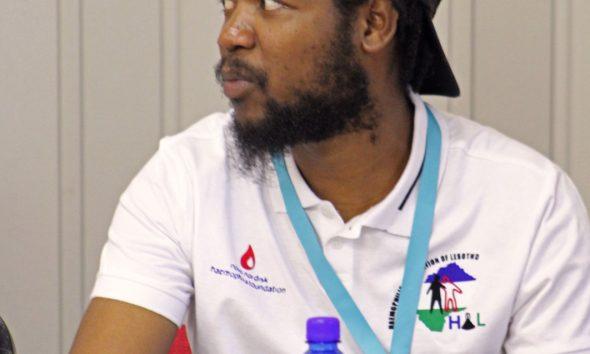Africa-Press – Lesotho. YOUR son has a bleeding disorder and is likely to bleed to death if not attended to urgently. ” Very few parents have received such a scary statement from their family doctors.
But for Retšelisitsoe Mahlaha’s parents in Lithabaneng, in the southern outskirts of Maseru, confirmation that he had haemophilia – a rare hereditary blood disorder disease – was no surprise.
They had always suspected that their son had haemophilia although several doctors they visited had not confirmed their suspicions. In 2021, almost 234 000 people were confirmed to have haemophilia worldwide according to the 2021 Statista report.
Last year Lesotho had at least 38 haemophilia patients according to Novo Nordic Haemophilia Foundation. Haemophilia is a disorder in which blood doesn’t clot normally, leading to excessive bleeding occurring after any injury.
A patient excessively bleeds externally or internally, depending on the kind of injury or organ damage. Symptoms include large or deep bruises, joint pain and swelling, unexplained bleeding and blood stains in urine or stool.
The biggest risk factor of haemophilia is to have family members who also have the disorder. Males are much more likely to have haemophilia than females according to experts.
Haemophilia A is a hereditary blood disorder primarily affecting males, caused by a deficiency of the blood clotting protein known as Factor VIII. Factor VIII is the protein that is deficient or defective in patients with classical haemophilia.
Lack of this protein results in abnormal bleeding. Haemophilia B is a hereditary bleeding disorder caused by a lack of blood clotting factor IX, a zymogen enzyme of the blood coagulation cascade.
Without enough factor IX, blood cannot clot properly to control bleeding according to Centres for Disease Control and Prevention. These disorders affect males more often than females because females have an additional X chromosome that acts as a “back-up,”.
Because males only have one X chromosome, any mutation in the factor VIII or IX gene will result in haemophilia. Females with a mutation on one X chromosome are called “carriers”.
Haemophilia always occur in boys and is passed on from mother to son through one of the mother’s genes. Mahlaha, who says his brother died at only nine months, does not remember when exactly the haemophilic symptoms showed in him because he was still very young.
At first, he says, his parents would take him from one doctor to the next but none of them believed when the parents said they suspected he had haemophilia.
But he recalls that when he was still very young he was constantly warned about playing competitive rough games such as football out of fear that he might injure himself.
His parents knew that his bleeding would only be stopped by a medica practitioner should someone hit him on the nose by accident or, as it often happens in football games, he scratched when falling on the ground.
Mahlaha, now 31, recalls that when he was below 10-years he was hyperactive and would sometimes engage in activities that caused minor injuries but that ended in him being admitted in hospital.
His hyperactivity as a child, he recalls, reached its peak when he fell from a tree at Accelerated Christian Education (ACE) Primary School in Maseru.
“I fell from the tree and bit my tongue, which led to bleeding profusely,” Mahlaha says.
“Teachers had already been made aware of my condition and they immediately called my parents,” he says.
Mahlaha says he was admitted at the Queen Elizabeth II Hospital but the bleeding did not stop until he was transferred to Bloemfontein. “At the time I was weak and tired after losing too much blood.
” He was transfused with blood.
Before that he would always be transferred to Ladybrand after one doctor who listened to his parents tested and officially diagnosed him with haemophilia.
At the time, local doctors were unfamiliar with the disease and there was no haemophilia treatment in the country. As a child living with haemophilia he got admitted several times because his hyperactivitiness.
Mahlaha’s experience mirrors the extent to which Lesotho needs specialist doctors who should treat haemophilia. There is no cure for haemophilia but it can be treated by helping blood to form clots to stop the bleeding.
Mahlaha says the journey of growing up with this rare disease was quite tough. “Back then doctors wouldn’t take my parents seriously when they said they suspected I had haemophilia,” he says.
“It was so fortunate that one of the doctors took an initiative to run the tests, I was then diagnosed and referred elsewhere because there was no treatment here.
“It was a challenge for me to speak out about this condition because everyone who knew would be so extra careful around me,” he says, adding: “That would restrict me as they would remind me of what not to do.
” Another young man living with haemophilia, Ramolibeli Mohlaoli, says he started showing symptoms when he was only three months old.
Mohlaoli says his journey with haemophilia was marked by excessive nose bleeds, bleeding of gums, swollen joints and joint stiffness. “I would swell when I crawled and whenever they tried to pick me up or when I fell,” Mohlauli says.
He says sometimes he would miss classes when he had such incidents back in primary school as he would be in hospital for up to three months being closely monitored.
During an awareness training in Thaba-Bosiu recently, Head of Haemophilia Treatment Centre, Dr Benjamin Nwako, said haemophilia treatment is still a long way away.
“Some people develop inhibitors against Factor VIII replacement after getting the treatment for a while and may need to receive bypassing agents,” Dr Nwako said.
For More News And Analysis About Lesotho Follow Africa-Press






